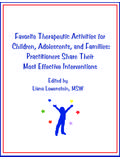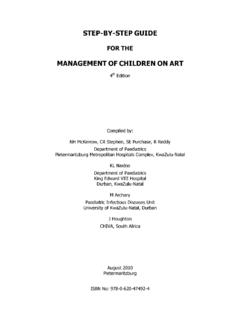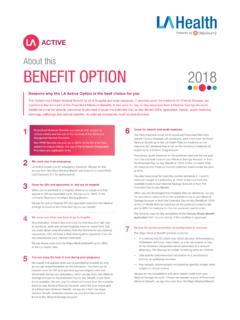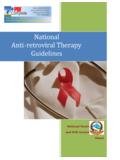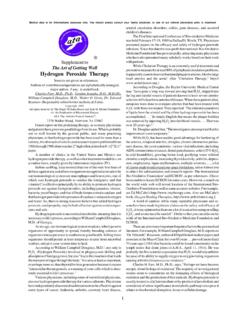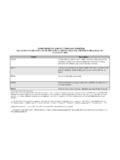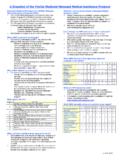Transcription of Guidelines for the Clinical Management of HIV Infection in ...
1 Guidelines for the Clinical Management of HIV Infection in Adults and Adolescents National AIDS-STD control programme Department of Health, Ministry of Health Myanmar Second Edition July 2007 2 Table of Contents List of experts who developed the List of abbreviations ..4 Introduction and Objectives ..6 HIV Two test Strategy for use in the general population ..8 Three test Strategy for use in Pregnant Women ..9 Voluntary confidential counselling and testing ..10 Clinical Assessment ..11 WHO Clinical Staging of HIV Disease ..11 Medical History and symptom check list ..12 Physical examination checklist ..13 Management and follow up plan based on WHO staging ..14 Visit schedule and follow up for patients commencing ART ..15 Assessment of Patients readiness for Initiating Antiretroviral Therapy.
2 16 Goals of Antiretroviral Mechanisms of action of antiretrovirals ..16 Classification of antiretrovirals by class ..16 When to start antiretroviral therapy in adults and adolescents ..17 CD4 testing not CD4 testing available ..17 Commencing ART in the presence of active opportunistic infections ..17 Managing opportunistic infections before starting antiretroviral Recommended first line antiretroviral regimens ..19 Starting ARV What to expect and what to Triple NRTI-based regimens ..20 Use of protease inhibitors (PIs) in initial therapy ..20 Starting and stopping NNRTIs ..21 ARV combinations not recommended ..21 Immune reconstitution inflammatory syndrome (IRIS) ..21 Adherence ..23 Clinical and laboratory monitoring prior to commencing and on first line Antiretroviral drug Class adverse drug reactions to nucleoside reverse transcriptase inhibitors.
3 26 Class adverse drug reactions to non-nucleoside reverse transcriptase inhibitors ..26 Class adverse drug reactions to protease inhibitors (PIs) ..26 Symptom directed toxicity Management Individual drug substitutions for toxicity and intolerance ..29 Notes on Stavudine (d4T) ..29 Considerations for specific patients ..31 ART for women of childbearing potential or who are pregnant ..31 Interaction between ART and hormonal contraceptives ..32 Initiating ART in pregnant women ..32 ART in Tuberculosis/HIV co- Infection ..33 Initiating ART in patients with active Recommendations for patients on ART who develop active TB ..33 Second line ART for patients with TB indicating first-line ART Antiretroviral therapy for IDUs ..35 Viral hepatitis and chronic liver disease ..36 Opiod substitution therapy.
4 36 HIV and Hepatitis Hepatitis B Infection ..38 Hepatitis C ART failure and when to switch therapy ..40 Defining Immunological criteria for failure ..41 Choice of second-line regimens for treatment failure ..42 Boosted PI/NRTI combinations ..42 Symptom directed toxicity Management table for SECOND line Prevention of Mother to Child The comprehensive strategic approach ..44 3 Counselling for PMCT ..45 ARV prophylaxis for PMCT ..45 Nevirapine resistance and its Doses of antiretroviral prophylaxis drugs for PMCT ..47 Post exposure prophylaxis ..50 Occupational and non-occupational exposure Occupational post exposure prophylaxis ..51 Components of occupational Antiretrovirals for PEP ..54 Non-occupation post exposure prophylaxis (nPEP)..54 Summary of recommendations for occupational and non-occupational PEP.
5 56 Syndromic approach to the Management of opportunistic infections ..57 Annexes ..75 Annex 1 Criteria for HIV-Related Clinical Events in Adults and Adolescents ..75 Annex 2 Dosages of antiretroviral drugs for adults and adolescents ..79 Annex 3 Storage of Antiretrovirals ..81 Annex 4 Drugs that interact with ART ..82 Annex 5 Clinical diagnosis and Management of common opportunistic infections ..86 References ..89 List of experts who developed the Guidelines 1. Dr Min Thwe National AIDS programme manager 2. Dr Win Maung National TB programme manager 3. Dr Htin Aung National AIDS programme 4. Dr Aung San C. S. Specialist Hospital, Waibargi, N Okkalapa, Yangon 5. Dr Chit Htun Lecturer/Consultant Physician 6. Dr Htin Aung Saw C. S. Specialist Hospital, Waibargi, N Okkalapa, Yangon 7.
6 Dr Khin Yi Oo Head/Consultant Virologist, National Health Laboratory, Yangon 8. Dr Phyu Noe National TB programme 9. Prof Rai Mra Yangon General Hospital 10. Prof Samuel Kyaw Hla Consultant Paediatrician, Thingangyun Hospital 11. Dr Win Myat Aye Consultant Paediatrician, Magway 12. Prof Khin May Ohn Head, Department of Medicine, Institute of Medicine 2 13. Dr Riitta Dlodlo HIV programme coordinator, IUATLD 14. Dr Yasuda Tadashi UNICEF, Myanmar 15. Dr Angela Bailey AZG, Myanmar (REPLACE) 16. Dr Anorla Bailei AZG, Myanmar 17. Dr Lianne Kuppens WHO Myanmar 18. Dr Ying Ru Lo WHO South EAST Asia Regional Office (SEARO) 19. Mrs Phavady Bollen WHO Myanmar 20.
7 Dr Oscar Barreneche WHO Myanmar 21. Dr Catrina Casalini WHO TB group 22. Dr Chris Duncombe WHO Consultant (Editor) Acknowledgement The authors wish to acknowledge the contribution of the WHO South EAST Asia Regional Office (SEARO) for the source material used in these Guidelines : Management of HIV Infection and antiretroviral therapy in adults and adolescents: A Clinical Manual WHO South East Asia Regional Office (2006) 4 List of abbreviations TC lamivudine AB antibody ABC abacavir AFB acid-fast bacilli AIDS acquired immunodeficiency syndrome ALT alanine aminotransferase ANC Absolute Neutrophil count ART antiretroviral therapy ARV antiretroviral (drug)
8 AST aspartate aminotransferase ATS amphetamine type stimulants ATV atazanavir AZT zidovudine (also known as ZDV) twice daily CD4 count CD4+ T-lymphocyte CMV cytomegalovirus CNS central nervous system CSF cerebrospinal fluid CTX co-trimoxazole CXR chest X-ray d4T stavudine ddI didanosine DOT directly observed therapy EC enteric-coated EFV
9 Efavirenz FBC full blood count FDA Food and Drug Administration FDC fixed-dose combination FPV fos-amprenavir FTC furthicitibine GI gastrointestinal HDL high-density lipoprotein Hb haemoglobin HBV hepatitis B virus HCV hepatitis C virus hgc hard gel capsule HIV human immunodeficiency virus HSV herpes simplex virus IDV indinavir INH isoniazid IRIS immune reconstitution inflammatory syndrome LPV lopinavir MTCT mother-to-child transmission (of HIV)
10 NFV nelfinavir NNRTI non-nucleoside reverse transcriptase inhibitor nPEP Non-occupational post exposure prophylaxis NRTI nucleoside reverse transcriptase inhibitor NVP nevirapine OHL oral hairy leukoplakia OST opioid substitution treatment PCP Pneumocystis pneumonia PEP Post exposure prophylaxis PGL persistent generalized lymphadenopathy 5 PI protease inhibitor PK pharmacokinetic PML progressive multifocal leukoencephalopathy PMTCT prevention of mother-to-child transmission (of HIV)











